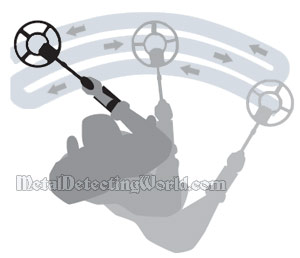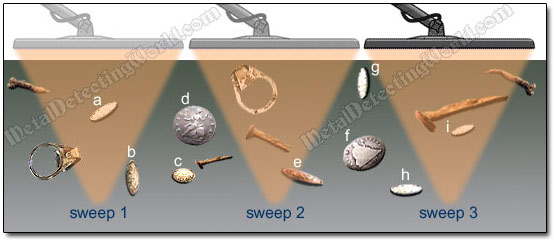Search Coils for Metal Detectors, page 8
Search Coil Swinging Discipline in Details
5) Sweep Overlapping
Overlap the sweeps by as much as 75% of the coil diameter, especially if Concentric, Monoloop, and Coaxial coil configurations are used.

Because the effective electromagnetic field detection pattern of the concentric, coaxial, and monoloop search coils is cone-shaped, overlapping is required with this type of coils. For comparison, the following illustrations depict side views of the search coil swept without overlapping, and with 25% and 50% overlaps.
'No Overlap' Case Study for Concentric Search Coil
Even though the underground target assortment depicted in illustrations is imaginable, it includes a couple of realistic cases of coins being masked by iron nails (see more details in "Detecting Masked Coins" on page 18). For the sake of this example, all targets are assumed to be aligned. Also it is assumed that the electromagnetic field detection pattern is uniformly effective, though, it is not in reality, and this will be discussed later on page 10.
As shown in the first illustration, sweeping the concentric coil without overlapping leaves most coins undetected, no matter how the coil's sweeps are placed in the picture. Three sweeps would result in detecting one shallow coin "a" (if its signal is not affected by a small iron nail on the left) in sweep 1, a pull-tab in sweep 2, and a large iron nail in sweep 3.
Concentric Search Coil Sweeps without Overlapping

There is a slight possibility that a pull-tab in sweep 1 would be recovered along with coin "a," and if the hole rechecked for more signals, a coin "b" standing on edge would be "caught" - an impossible case for a beginner (this will be covered on page) but not for a pro. An experienced detectorist most likely would scan the walls of the hole and get the responses from coins "c" and "d", or dig a wide hole and discover these coins in a dirt pile.
The pull-tab in sweep 2 will be dug up if not rejected by Discrimination. Everything else would be masked by mid-sized iron nail, would not respond, and, therefore, ignored by the detectorist. He/she would hear the Threshold going "blank" for a second because of the nail (if iron is discriminated), but likely would ignore it anyway.
Even if the Discrimination control is set up high, a large nail in sweep 3 would produce a silver-like response due to its large size and the Halo effect. A small silver coin "i" beneath the nail is completely masked by it and would not be "seen" by a detector, but would be dug up along with the nail. So now this recovery could have many possible outcomes. But I will describe the simplest one for the sake of the newcomers to this hobby.
One outcome would be like this: after the dirt is taken out of the hole and piled up, the coin happens to be on top of the dirt pile and above nail. As the pile is checked for a signal, the coin is sounding loud and clear, and then picked up by the detectorist. If he/she scans the pile again, the nail would not respond as the halo effect has been destroyed. If iron is discriminated, the Threshold will go "blank" for a second when the coil is passed over the nail. What happens next is very interesting.
A beginner will be satisfied with his/her coin find and will not pick up the nail from the dirt pile, and will not recheck the pile for possibly more signals again. Well, we know there is nothing else in it, but sometimes there are two coins stuck together underground. After the coins get separated and taken out along with the dirt and nail (in this case) during recovery, the second coin is usually ignored and left behind. And less likely would a beginner recheck the hole.
A veteran detectorist would certainly scan the hole and hear a faint response from the deep coin "h", and possibly get another faint signal from the edge of the coin "f". By digging coin "f" up, this detectorist would not be able to miss the shallow coin "g" standing on edge. And if this person is persistent, he/she would scan the walls of the hole and get a response from the coin "e" despite its close proximity to a mid-sized iron nail in sweep 2. A pro would get all eight coins from this small patch of the ground!
Even from just one outcome chosen, I may develop a web of new possible scenarios, and this could continue endlessly until the last nonferrous target is recovered. But what could be learned from my example? A few very simple and effective measures that can be taken to make sure most of the valuable targets are recovered:
1) investigate every questionable sound
2) dig larger holes (if possible) and scan their walls
3) dig deeper holes (as much as the Fiskars shovel's blade deep)
4) pick up the dug targets from a dirt pile and recheck the pile (or the dirt plug) for more signals
5) at least do not discriminate all nonferrous targets (ideally the Discrimination control should be at minimum level just to reject small nails)
6) OVERLAP!!! At least 25%